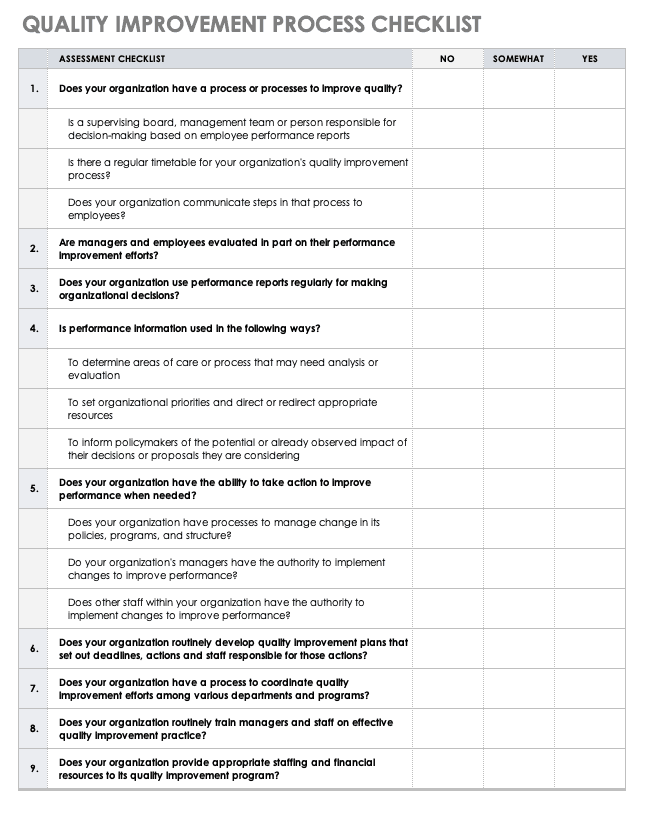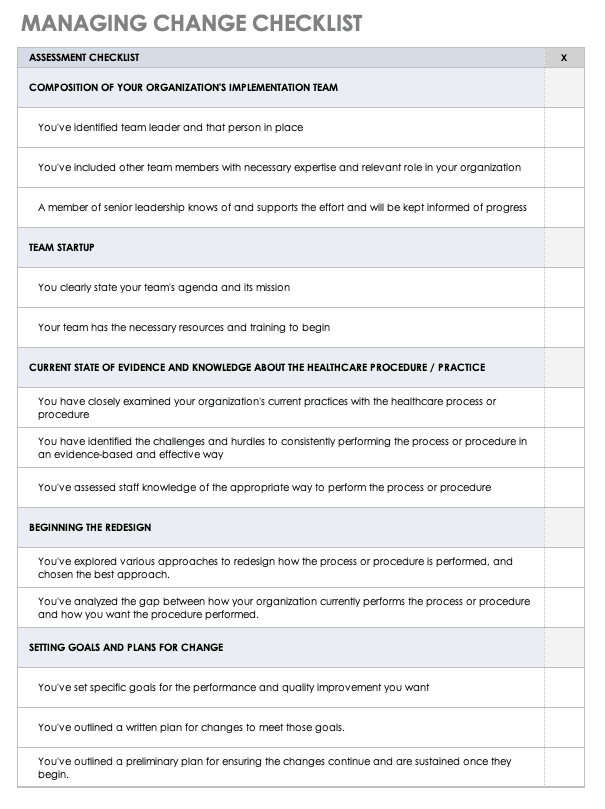What Is Continuous Quality Improvement in Nursing?
Continuous quality improvement in nursing includes a few broad areas:
- Quality Assurance: This ensures that your organization provides services that meet appropriate standards for good healthcare.
- Quality Improvement: This ensures that everyone in every department of your organization is always working to deliver better healthcare for patients.
- Problem Resolution: This ensures that all of your organization’s departments communicate and work well together.
Learn more about the primary principles of quality improvement, including expert tips for effective quality improvement, in “A Business Guide to Effective Quality Improvement in Healthcare.” To find out more about national standards and guidelines in continuous quality improvement, check out “Continuous Quality Improvement in Healthcare: Principles, Process, and Tools.”
Health Professionals Who Have a Role in Quality Improvement in Nursing
Healthcare professionals, including nurses, play important roles in quality improvement in nursing. Sometimes, these healthcare professionals come together as organized groups to shape the role of nursing in the healthcare industry. Here are some important titles and groups:
- Nurse Executive: This person sets up the structure and ensures that resources are available for quality improvement work.
- Nurse Manager: A nurse manager oversees staff nurses and can implement a structure to encourage quality improvement.
- Quality Assurance Coordinator: This person assists in executing quality improvement processes and collects data to show that the organization meets the requirements set out by insurers and regulatory agencies.
- Quality Circles, Quality Councils, and Quality Improvement Forums: These groups help coordinate effective quality improvement work.
- Quality Improvement Nursing Teams: These teams focus on specific ways in which professionals can improve nursing and healthcare in a facility.
- Staff Nurse: This person has the most direct role in delivering healthcare to patients and seeing where care isn’t as effective as it should be.
Examples include analyzing treatment protocols for patients with chronic heart failure or sepsis or determining how to improve protocols in order to avoid wrong-site surgeries — operations performed on the wrong arm or hip, for example.
“CQI nurses are vital to healthcare improvement efforts because they are able to strategically see the bird's-eye view via the data and because their hands-on clinical experience and knowledge can better inform the tactical process changes in order to drive improvements in clinical safety and quality,” Larivee says. “CQI nurses are the bridge to successful, sustainable quality improvement programs,” she adds.
Learn more about the best organizational foundations for effective quality improvement in “A Business Guide to Effective Quality Improvement in Healthcare.”
Nursing Quality Improvement Project Ideas and Guide on Improved Nursing Care
The Agency for Healthcare Research and Quality (AHRQ) is part of the U.S. Department of Health and Human Services. It focuses on gathering and producing evidence to improve healthcare, with an overall goal of delivering safer, more equitable, and more affordable care.
The AHRQ has produced guides, factsheets, and other information for improving nursing care and overall healthcare. The guides and factsheets offer project ideas for quality improvement in nursing, including the following:
- Improving healthcare-related communication about individual patients during shift changes of nurses or other healthcare professionals
- Improving nursing teamwork
- Improving patient safety by improving the nursing workload
- Preventing catheter-related infections
- Preventing falls and injuries in patients within healthcare facilities
- Preventing pneumonia that can come from airway ventilators used on patients — called ventilator-associated pneumonia
- Preventing pressure ulcers (bedsores) in patients within healthcare facilities
- Reducing medication errors
- Reducing nurse fatigue and stress
- Reducing staff turnover among nurses
What Is Quality Improvement in Nursing?
Quality improvement in nursing is similar to continuous quality improvement in nursing and to continuous quality improvement in healthcare overall. The terms continuous quality improvement and quality improvement are often used interchangeably in healthcare, as is the older term quality assurance.
Nursing and Other Organizations That Work to Promote Healthcare Quality Improvement
A number of nursing and healthcare organizations work to promote healthcare quality improvement through education, publishing materials, and guidelines and standards.
Here are some of the leading nursing organizations championing quality improvement:
- American Nurses Association (ANA): This is a leading nursing organization representing roughly 4 million registered nurses in the United States.
- The American Nurses Credentialing Center Magnet Recognition Program: Operated by a subsidiary of the ANA, this program gives “magnet” recognition to healthcare facilities that show extraordinary excellence in nursing services.
- Nursing Alliance for Quality Care (NAQC): This is a nonprofit partnership of leading nursing organizations and other healthcare groups. It is now managed by the American Nurses Association.
Other leading organizations for promoting quality improvement in healthcare include the following:
- Hospital Compare
- Hospital Quality Alliance
- Institute for Healthcare Improvement
- The Joint Commission
- National Coordinating Council for Medication Error Reporting and Prevention
- National Quality Forum
- Physician Consortium for Performance Improvement
The American Nurses Association’s Role in Quality Improvement Efforts
Dating back to 1896, the American Nurses Association has worked for quality improvement in nursing for much of its existence. In more recent decades, it has focused on quality improvement through the following methods:
- Advocacy: It encourages legislation to increase patient safety and improve healthcare and promotes those goals in other ways.
- Feedback: It provides feedback to other national quality improvement organizations in healthcare.
- Research: It helps fund research to learn more about nursing quality and how to measure its effect on patient outcomes. Through NDNQI and other data, research projects have analyzed the following:
- How healthcare organizations classify patients and their conditions in terms of understanding the staffing needed to improve their outcomes
- The impact of the healthcare industry on the U.S. economy
- The relationship between nurse staffing levels and patient outcomes
- Standards: It has developed some of its own standards, including the National Database of Nursing Quality Indicators® (NDNQI®).
The Research Efforts in Nurse Quality and Quality Improvement in Nursing
Here are more resources that are instrumental to research efforts in nurse quality and quality improvement in nursing:
Quality Improvement Theory in Nursing
Quality improvement theory in nursing is the same as in healthcare generally.
Beginning two decades ago, many nursing educators began advocating for nursing schools to do more to teach quality improvement theory to nurses.
“In the future, the clinical and economic interests of nurses will depend heavily on their ability to improve quality,” Linda Norman, a Senior Associate Dean for Academics at Vanderbilt University’s School of Nursing, wrote in the journal Nursing Outlook in 2001.
“Thus, to advance as a profession in the years ahead, nurses will need good data on measures of quality that are linked to nursing, and they will need to know how to use this data to continuously improve the quality of nursing care,” she noted.
Since then, nursing schools have been increasingly teaching quality improvement theory and methods in their education programs.
One umbrella effort has been the Quality and Safety Education for Nurses Institute — or QSEN Institute — housed at the Frances Payne Bolton School of Nursing at Case Western University. The institute is a collaboration between nursing and healthcare leaders who gather the best information on good nursing and healthcare practices.
Is your organization ready for effective quality improvement? Use this template to understand questions your organization must ask to assess whether it can execute good quality improvement. This template is free for download, and you can customize it to fit your needs.
Download Quality Improvement Process Template
Learn more about the history of quality improvement and about leaders who developed the concept — in general and in healthcare — in “Continuous Quality Improvement in Healthcare: Principles, Process, and Tools.”
Nursing Leaders’ Important Historical Role in Advancing CQI in Healthcare
For more than two decades, nurses and nursing leaders have been at the forefront of advancing CQI in healthcare.
As a practicing nurse in the 1980s, Schumann remembers how nurses could see healthcare practices and procedures that were harmful — even contributing to patient deaths. But nurses were told they didn’t have the data to back up their concerns, Schumann says.
ANA and others started thinking about how to collect that data, focus on improvement, and understand the benefits of good nursing. “That’s how we got to the nursing outcome indicators,” Schumann says. Their goal, she says, was to answer the following question: “How do you measure the impact of nursing?”
Nurses Continue to Play a Vital Role in Quality Improvement in Healthcare
Nurses remain vital to continuous quality improvement in healthcare. In fact, many believe they might have the most important position — because they are in the best position to see how providers deliver and can improve healthcare services.
There are two reasons for their unique perspective on this issue:
- They are around patients all the time and see the problems and inefficiencies firsthand.
“You hear people describing the ‘sharp points’ of healthcare. Those individuals at the sharp points are those actually laying hands on patients — doing the work of patient care,” Sargent says. Most often, those are nurses, she says. Through her work as a nurse, “I really understood the problems and where there were horrible inefficiencies or gaps in quality — and areas of risk.”
- Nurses also understand most parts of a healthcare organization’s systems and processes.
“I also think nurses get the whole picture,” says BYU’s Merrill. “They see all aspects.
”For example, Merrill says, when an organization works on decreasing pressure ulcers (or bedsores), nurses understand how an organization’s nutrition experts can help — because nutrition can have a bearing on the skin breaking down more easily. Or the nurse will know about the vendor that provides the hospital beds and changes that could be made to decrease bedsores. “The nurse knows all of the stakeholders,” she says.
Learn more about the benefits of good quality improvement programs, along with the main questions to answer as part of your quality improvement work, in “A Business Guide to Effective Quality Improvement in Healthcare.”
What Are Examples of Quality Improvement in Nursing?
Quality improvement in nursing are initiatives created to improve patient outcomes and upgrade the overall quality of care. Examples include reducing medical errors, increasing staff communication, implementing evidence-based practices, and upgrading discharge planning.
Experts interviewed for this article cited two nursing-related quality improvement projects they were involved with that were simple, but very beneficial. They both addressed hospital or nursing storage areas.
- A More Organized Storage Closet:
In the end, “nurses were coming from other floors” to use the closet, McAdams says, because it was easier to quickly get the materials they needed.
- Better Placement of a Supply Area:
-
Wilson says that at first workers were concerned about the timing, but as part of the project, they recorded the distance workers walked to get certain materials and supplies. That supply area was then moved closer to the workers, Wilson says.
You can use a process checklist to help manage a quality improvement process. Use this template, designed specifically for implementing and executing an effective quality improvement process. This template is free for download, and you can customize it to fit your needs.
Download Managing Change Quality Improvement Template
See more real-world examples of continuous quality improvement projects in healthcare in the “Largest Roundup of Healthcare Improvement Examples and Projects.”
What Is a Quality Improvement Management Nurse and What Do They Do?
Increasingly, healthcare organizations are creating positions and hiring professionals — including nurses — who are focused only on healthcare and nursing quality improvement.
An increasingly common job title is quality improvement management nurse. The person in that job does the following:
- Combines expertise in healthcare, quality improvement, and management to lead systemic improvements in policies and processes
- Continually assesses performance data and trends in healthcare metrics
- Continually works with other organization managers to ensure that problems in healthcare processes are identified and fixed
- Ensures the organization complies with requirements from state and federal agencies and the Joint Commission, which accredits hospitals
- Helps design and execute training programs
- Provides feedback and recommendations for improvement to an organization’s top leaders
- Solicits and collects feedback from patients, employees, and members of the public
Strategies for Quality Improvement in Critical Care Nursing
Experts have also made recommendations for quality improvement in critical care nursing. The process, of course, is similar to quality improvement in other nursing areas, as well as healthcare quality improvement in general. Recommendations include the following:
- Choose the right healthcare metric to measure. The metric needs to be a relevant gauge for true health benefits. An example of a good metric is the rate of catheter-related urinary tract infections, which have been a problem throughout the U.S. healthcare system.
- Collect the best and most relevant data. The development of electronic health records for all patients helps here, compared to decades ago when data was handwritten on paper within patient charts. But there is still information outside of electronic health records that can be helpful for understanding how to improve a healthcare process.
- Disseminate the data. The medical teams involved must understand what the current data shows about a healthcare process and recognize how that data is changing as the process shifts. You can better engage everyone involved by using charts and graphics to show the data.
- Empower nurses. There are more nurses than any other group of healthcare workers, and their jobs put them in positions to understand problems and make change. They are often motivated to bring about change, and quality improvement systems need to take advantage of that, along with their experience and abilities.
Quality Improvement Tools in Healthcare and Nursing
Quality improvement tools in nursing are the same as quality improvement tools in healthcare in general. You can learn more about some of these tools in “A Business Guide to Effective Quality Improvement in Healthcare.”
Implement Quality Improvement in Nursing with Smartsheet for Healthcare
Empower your people to go above and beyond with a flexible platform designed to match the needs of your team — and adapt as those needs change.
The Smartsheet platform makes it easy to plan, capture, manage, and report on work from anywhere, helping your team be more effective and get more done. Report on key metrics and get real-time visibility into work as it happens with roll-up reports, dashboards, and automated workflows built to keep your team connected and informed.
When teams have clarity into the work getting done, there’s no telling how much more they can accomplish in the same amount of time. Try Smartsheet for free, today.







